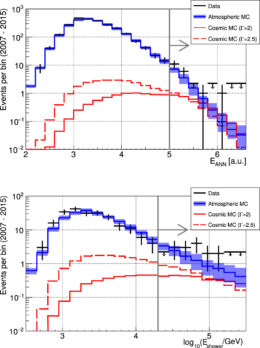How do we hunt for elusive neutrinos emitted by distant astrophysical sources? Submerge a huge observatory under ice or water … and then wait patiently.
Sneaky Messengers
Neutrinos — tiny, nearly massless particles that only weakly interact with other matter — are thought to be produced as a constant background originating from throughout our universe. In contrast to known point sources of neutrinos (for instance, nearby supernovae), the diffuse flux of cosmic neutrinos could be emitted from unresolved astrophysical sources too faint to be individually detected, or from the interactions of high-energy cosmic rays propagating across the universe.
Observations of this diffuse flux of cosmic neutrinos would be a huge step toward understanding cosmic-ray production, acceleration, and interaction properties. Unfortunately, these observations aren’t easy to make!

Diagram showing the path of a neutrino from a distant astrophysical source (accelerator) through the Earth. It is eventually converted into an upward-traveling muon that registers in the ANTARES detector under the sea. [ANTARES]
Looking for What Doesn’t Want to Be Found
Because neutrinos so rarely interact with matter, most pass right through us, eluding detection. The most common means of spotting the rare interacting neutrino is to look for Cherenkov radiation in a medium like ice or water, produced when a neutrino has interacted with matter to produce a charged particle (for instance, a muon) moving faster than the speed of light in the medium.
Muons produced in our atmosphere can also register in such detectors, however, so we need a way of filtering out these non-cosmic background events. The solution is a clever trick: search for particles traveling upward, not downward. Atmospheric muons will come only from above, whereas muons produced by neutrinos should travel through the detectors in all directions, since cosmic neutrinos arrive from all directions — including from below, after passing through the Earth.
Observatories on the Hunt
Neutrino observatories are often built to take advantage of pre-existing deep bodies of ice or water for their detectors. One of the most well-known neutrino observatories is IceCube, an array of detectors located far beneath the Antarctic ice. A few years ago, IceCube announced the observation of an excess of events over the expected atmospheric background — the first detection of a diffuse flux of cosmic neutrinos. The next step: confirmation from another observatory.

ANTARES detections across different energy bins, for both track-like (top) and shower-like (bottom) events. Plot includes data (black), model for atmospheric events (blue), and two different models for cosmic events (red). Above an energy cutoff of 20 TeV (grey line), nine excess neutrinos are detected relative to the atmospheric model. [Albert et al. 2018]
A Mild Excess
The outcome? Success! …sort of.
The very nature of neutrinos’ elusiveness means that we have to draw conclusions with very small numbers of detections. Over nine years, ANTARES detected a total of 33 events above an energy cutoff of 20 TeV, whereas models predict it should have seen only 24 such events due to atmospheric particles. This detection of nine extra neutrinos may sound insubstantial — but statistically, it allows the team to reject the hypothesis that there is no diffuse cosmic flux at an 85% confidence level.
The “mild excess” of neutrinos detected by ANTARES is by no means a smoking gun, but the properties of this cosmic neutrino flux are consistent with those detected by IceCube, which is a very promising outcome. At the moment, it would seem that a diffuse flux of cosmic neutrinos is present — and the next generation of neutrino observatories may be what we need to properly characterize it.
Citation
A. Albert et al 2018 ApJL 853 L7. doi:10.3847/2041-8213/aaa4f6


2 Comments
Pingback: Nueve años en la ‘caza’ submarina de neutrinos – Las Divagaciones de Miriam al-Mayiriti
Pingback: Nueve años en la ‘caza’ submarina de neutrinos | Alef